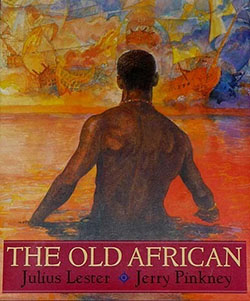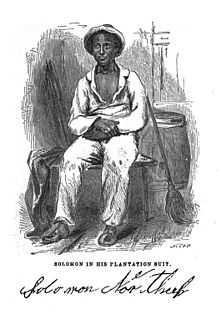 W
WAmerican Slavery as It Is: Testimony of a Thousand Witnesses is a book written by the American abolitionist Theodore Dwight Weld, his wife Angelina Grimké, and her sister Sarah Grimké, which was published in 1839.
 W
WThe Atlantic slave trade to Brazil refers to the period of history in which there was a forced migration of Africans to Brazil for the purpose of slavery. It lasted from the mid-sixteenth century until the mid-nineteenth century. During the trade, more than three million Africans were transported across the Atlantic and sold into slavery. It was divided into four phases: The Cycle of Guinea ; the Cycle of Angola which trafficked people from Bakongo, Mbundu, Benguela and Ovambo; Cycle of Costa da Mina, now renamed Cycle of Benin and Dahomey, which trafficked people from Yoruba, Ewe, Minas, Hausa, Nupe and Borno; and the Illegal trafficking period, which was suppressed by the United Kingdom (1815-1851). During this period, to escape the supervision of British ships enforcing an anti-slavery blockade, Brazilian slave traders began to seek alternative routes to the routes of the West African coast, turning to Mozambique.
 W
WBarracoon: The Story of the Last "Black Cargo" is a non-fiction work by Zora Neale Hurston. It is based on her interviews in 1927 with Cudjoe Lewis, the last presumed living survivor of the Middle Passage. The book failed to find a publisher at the time, in part because it was written in vernacular, and also in part because it described the involvement of other African people in the business of Atlantic slave trade.
 W
WThe Bondwoman's Narrative is a novel by Hannah Crafts, a self-proclaimed slave who escaped from North Carolina. She likely wrote the novel in the mid-19th century. However, the manuscript was not authenticated and properly published until 2002. Some scholars believe that the novel, written by an African-American woman and former slave, was written between 1853 and 1861. It is one of the very few books by a fugitive slave woman, others include the novel Our Nig by Harriet Wilson, published in 1859, and the autobiography Incidents in the Life of a Slave Girl by Harriet Jacobs, published in 1861.
 W
WMary Prince was a British abolitionist and autobiographer, born in Bermuda to an enslaved family of African descent. Subsequent to her escape, when she was living in London, England, she and Thomas Pringle wrote her slave narrative The History of Mary Prince (1831), which was the first account of the life of a black woman to be published in the United Kingdom. This first-hand description of the brutalities of enslavement, released at a time when slavery was still legal in Bermuda and British Caribbean colonies, had a galvanising effect on the anti-slavery movement. It was reprinted twice in its first year.
 W
WIncidents in the Life of a Slave Girl, written by herself is an autobiography by Harriet Jacobs, a mother and fugitive slave, published in 1861 by L. Maria Child, who edited the book for its author. Jacobs used the pseudonym Linda Brent. The book documents Jacobs's life as a slave and how she gained freedom for herself and for her children. Jacobs contributed to the genre of slave narrative by using the techniques of sentimental novels "to address race and gender issues." She explores the struggles and sexual abuse that female slaves faced as well as their efforts to practice motherhood and protect their children when their children might be sold away.
 W
WThe Interesting Narrative of the Life of Olaudah Equiano, Or Gustavus Vassa, The African, first published in 1789 in London, is the autobiography of Olaudah Equiano. The narrative is argued to represent a variety of styles, such as a slavery narrative, travel narrative, and spiritual narrative. The book describes Equiano's time spent in enslavement, and documents his attempts at becoming an independent man through his study of the Bible, and his eventual success in gaining his own freedom and in business thereafter.
 W
WZamba Zembola is the supposed author of an 1847 slave narrative, The Life and Adventures of Zamba, an African Negro King; and his Experience of Slavery in South Carolina, which describes his kidnapping and 40 years of labor as a slave on a plantation in the U.S. state of South Carolina. The work was edited by Peter Neilson, a Scottish abolitionist.
 W
WThe Life of Josiah Henson, Formerly a Slave, Now an Inhabitant of Canada, as Narrated by Himself is a slave narrative written by Josiah Henson, who would later become famous for being the basis of the title character from Harriet Beecher Stowe's 1852 novel Uncle Tom's Cabin. The Life of Josiah Henson, published in 1849, is Henson's first work but was dictated to Samuel A. Eliot, who was a former Boston Mayor known for his anti-slavery views. Although Henson was an accomplished orator, he had not yet learned to read and write. The narrative provides a detailed description of his life as a slave in the south.
 W
WMy Bondage and My Freedom is an autobiographical slave narrative written by Frederick Douglass and published in 1855. It is the second of three autobiographies written by Douglass, and is mainly an expansion of his first, discussing in greater detail his transition from bondage to liberty. Following this liberation, Douglass, a former slave, went on to become a prominent Abolitionist, speaker, author, and publisher.
 W
WNarrative of the Life of Frederick Douglass is an 1845 memoir and treatise on abolition written by famous orator and former slave Frederick Douglass during his time in Lynn, Massachusetts. It is generally held to be the most famous of a number of narratives written by former slaves during the same period. In factual detail, the text describes the events of his life and is considered to be one of the most influential pieces of literature to fuel the abolitionist movement of the early 19th century in the United States.
 W
WNever Forgotten is a 2011 picture book by Pat McKissack about a blacksmith father in West Africa who has Musafa, his son, kidnapped by slavers and with the assistance of the four elements discovers that Musafa is working in Charleston as a blacksmith's apprentice.
 W
WThe Old African is a 2005 book by Julius Lester and illustrated by Jerry Pinkney. It is based on an incident at Igbo Landing and is about Jaja, a slave who leads a group of plantation slaves back to Africa by walking into the ocean.
 W
WOur Nig: Sketches from the Life of a Free Black is an autobiographical novel by Harriet E. Wilson. First published in 1859, it was rediscovered in 1981 by Professor Henry Louis Gates, Jr. and was subsequently reissued with an Introduction by Gates. Our Nig has since been republished in several other editions. It was considered the first novel published by an African-American woman in North America, though that record is now contested by another manuscript found by Gates, The Bondwoman's Narrative.
 W
WThe People Could Fly: American Black Folktales is a 1985 collection of twenty-four folktales retold by Virginia Hamilton and illustrated by Leo and Diane Dillon. They encompass animal tales, fairy tales, supernatural tales,and tales of the enslaved Africans.
 W
WSlave Narratives: A Folk History of Slavery in the United States was a massive compilation of histories by former slaves undertaken by the Federal Writers' Project of the Works Progress Administration from 1936 to 1938. It was the simultaneous effort of state-level branches of FWP in seventeen states, working largely separately from each other.
 W
WTo Be A Slave is a 1968 nonfiction children's book by Julius Lester, illustrated by Tom Feelings. It explores what it was like to be a slave. The book includes many personal accounts of former slaves, accompanied by Lester's historical commentary and Feelings' powerful and muted paintings. To Be a Slave has been a touchstone in children literature for more than 30 years.
 W
WTwelve Years a Slave is an 1853 memoir and slave narrative by American Solomon Northup as told to and edited by David Wilson. Northup, a black man who was born free in New York state, details his being tricked to go to Washington, D.C., where he was kidnapped and sold into slavery in the Deep South. He was in bondage for 12 years in Louisiana before he was able to secretly get information to friends and family in New York, who in turn secured his release with the aid of the state. Northup's account provides extensive details on the slave markets in Washington, D.C. and New Orleans, and describes at length cotton and sugar cultivation and slave treatment on major plantations in Louisiana.
 W
WUp from Slavery is the 1901 autobiography of American educator Booker T. Washington (1856–1915). The book describes his personal experience of having to work to rise up from the position of a slave child during the Civil War, to the difficulties and obstacles he overcame to get an education at the new Hampton Institute, to his work establishing vocational schools—most notably the Tuskegee Institute in Alabama—to help black people and other disadvantaged minorities learn useful, marketable skills and work to pull themselves, as a race, up by the bootstraps. He reflects on the generosity of both teachers and philanthropists who helped in educating blacks and Native Americans. He describes his efforts to instill manners, breeding, health and a feeling of dignity to students. His educational philosophy stresses combining academic subjects with learning a trade. Washington explained that the integration of practical subjects is partly designed to reassure the white community as to the usefulness of educating black people.